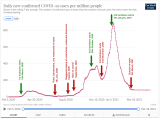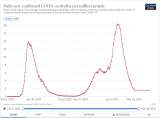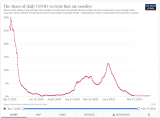You are using an out of date browser. It may not display this or other websites correctly.
You should upgrade or use an alternative browser.
You should upgrade or use an alternative browser.
Herve's Bar & Grill
- Thread starter edX
- Start date
pds
Registered
I just finished reading “The boys on the boat” (ok listing to on audible) and am struck by the idea of that deep unity of heart that propelled the boys. Seems we don’t often get to that point when you‘re not just in the zone but bound to others in that zone. I got the feeling that is part of our present national malaise, that we are preoccupied with how I look or how I'm seen and slogging through without a vision for what we could be. A lot of the young people I work with have never felt anything like it. Maybe the guys in an army platoon find a facsimile of it,
ok. I think I’ve had one too many. I’ll stop now. Barkeep, my tab please.
Great read though. I recommend it (and the delivery system).
ok. I think I’ve had one too many. I’ll stop now. Barkeep, my tab please.
Great read though. I recommend it (and the delivery system).
pds
Registered
Hey ksv! good to see ya - have one on me.
Well, seems the Senate Majority is set on preserving our precious National Monuments. Let's all raise a glass to Monumental Hypocrisy as our dear friend Mitch promises to push through a new Supreme Court justice 46 days ahead of a presidential election.
Well, seems the Senate Majority is set on preserving our precious National Monuments. Let's all raise a glass to Monumental Hypocrisy as our dear friend Mitch promises to push through a new Supreme Court justice 46 days ahead of a presidential election.
Satcomer
In Geostationary Orbit
If you have a recent iPhone or iPad, you already have a silicon. But it will be a big transition to a desktop or laptop silicon. Developers need to update apps to support Silicon. Translate to massive updates if your favorite apps will even port to it.
This is what I believe is true through Mac history! That is also the reason I wait until Mac OS is on version 2 of the product for longevity!
Merry Christmas too all unless you'd rather celebrate Festivus (for the rest of us). In all cases, we've turned a corner and headed for the light. As Roger and Pete said "gotta feeling' 21 is gonna be a good year."
2021 will surely be a good year. 2020 prepared the way: when you exit an ugly tunnel, the sun always looks bright.
Satcomer
In Geostationary Orbit
To me I wanted to keep up this cordial thread, so Bartender pour me another drink! 
So what is everybody doing with these lockdown orders I’m starting to think thatto me it seems NOT be flattening the curve at all and have made it worse!
To me as a fellow Human animal we should go on as usually because humans need interaction with people and we citizens need to argue against lockdowns because they don’t work!
I just wanted to get that off army chest today!
So what is everybody doing with these lockdown orders I’m starting to think thatto me it seems NOT be flattening the curve at all and have made it worse!
To me as a fellow Human animal we should go on as usually because humans need interaction with people and we citizens need to argue against lockdowns because they don’t work!
I just wanted to get that off army chest today!
Actually, I respectfully disagree with you. Lockdowns do work - when people follow them. Yes, most humans need interaction with others. But if people followed the simple request and the phases as the lockdown had eased, the time under lockdown would not be so bad and we could have gotten back to life as usual sooner.
It is when people think they won't contract the virus because they never get sick and they snub the request of wearing a mask, staying six feet apart from others and going out only when absolutely necessary. That is when the virus get spread to others whose body can not handle the fight of the virus.
Take the Sturgis event as an example. All those people traveled from many different states and when they went home they not only got the virus but spread it to their family and to others in their community. If they stayed home, the chances are they would not have gotten sick or at least not spread it to others.
I can still wave to my neighbors and chat with them while standing in our own yards. Zoom meetings have been great to keep in contact with those from out of town or across town. I still have human contact.
It is when people think they won't contract the virus because they never get sick and they snub the request of wearing a mask, staying six feet apart from others and going out only when absolutely necessary. That is when the virus get spread to others whose body can not handle the fight of the virus.
Take the Sturgis event as an example. All those people traveled from many different states and when they went home they not only got the virus but spread it to their family and to others in their community. If they stayed home, the chances are they would not have gotten sick or at least not spread it to others.
I can still wave to my neighbors and chat with them while standing in our own yards. Zoom meetings have been great to keep in contact with those from out of town or across town. I still have human contact.
bbloke
Registered
I have to agree with Cheryl: lockdowns do work and there is data to show this. I agree there are caveats: people have to follow them, rules need to be informed by the science, and the rules need to be clear.
In the UK, we can see this with the graphs of the number of cases, hospitalizations, and deaths. The first lockdown (16 March, 2020) was late but did drive down the cases. The government then tried to open up the country quite quickly over the summer and get back to normal-ish, but the scientists were uneasy. Guess what... cases started to shoot up again. The second lockdown started on 31 October, 2020. Cases began coming down again. The government didn’t want to be the ones that cancelled the holidays and so told everyone to enjoy their Christmas and New Year... Very predictably, a few days after Christmas, another spike began... The government was again very slow to act but declared another lockdown on 4 January, 2021. Cases are coming down again and, thank goodness, we have a vaccination programme now too.
There are various sites for collections of graphs. Here’s one example for the UK: https://www.theguardian.com/world/2...-uk-covid-cases-deaths-and-vaccinations-today
I know it‘s pretty awful for everyone, not being able to do the things we’re used to, missing friends and family, and some suffering from mental health issues as a result of the isolation and anxiety. But for the sake of protecting those around us and to help those on the medical frontline, we need to stick to it, limit the spread, and give the vaccinations time to start having an effect.
In the UK, we can see this with the graphs of the number of cases, hospitalizations, and deaths. The first lockdown (16 March, 2020) was late but did drive down the cases. The government then tried to open up the country quite quickly over the summer and get back to normal-ish, but the scientists were uneasy. Guess what... cases started to shoot up again. The second lockdown started on 31 October, 2020. Cases began coming down again. The government didn’t want to be the ones that cancelled the holidays and so told everyone to enjoy their Christmas and New Year... Very predictably, a few days after Christmas, another spike began... The government was again very slow to act but declared another lockdown on 4 January, 2021. Cases are coming down again and, thank goodness, we have a vaccination programme now too.
There are various sites for collections of graphs. Here’s one example for the UK: https://www.theguardian.com/world/2...-uk-covid-cases-deaths-and-vaccinations-today
I know it‘s pretty awful for everyone, not being able to do the things we’re used to, missing friends and family, and some suffering from mental health issues as a result of the isolation and anxiety. But for the sake of protecting those around us and to help those on the medical frontline, we need to stick to it, limit the spread, and give the vaccinations time to start having an effect.
The US had the same results when states opened up way too early. But then we also had states that refused to acknowledge the science and the need to lock down. That's when they fudged the numbers to make it look like all is well. Stupidity.
Now it will be awhile before we can 'get back to normal'. But will it ever be back to normal? For many it will be a life of caution because of the unknown of these new variants of the virus.
Now it will be awhile before we can 'get back to normal'. But will it ever be back to normal? For many it will be a life of caution because of the unknown of these new variants of the virus.
Satcomer
In Geostationary Orbit
To me Lockdowns over the past year ever cured the spread! Take example of States still in harsh lockdown States compare a non lockdown State! I want to see if Texas, Florida and others compared to similar sized States that opened up! I want proof to see if lockdowns and masked States to unmasked States compared to deaths!
You should compare with positive cases, but then we have a problem with the states that manipulate the numbers like Florida (and possibly Texas). Then you have the deniers like South Dakota. I'm not sure we can get true numbers. Which states opened up and had to go back because the positive cases went up?
We went through the same mask/no mask, stay at home/go partying in 1918. That flu went around the world at least twice (some say three or four times) before people got smart.
We went through the same mask/no mask, stay at home/go partying in 1918. That flu went around the world at least twice (some say three or four times) before people got smart.
bbloke
Registered
I'll be less familiar with the details for the US and the reporting in individual states, but I can comment on what we've been seeing in the UK.
When the pandemic first hit, we had very little testing and people were also told to NOT visit their GPs (doctors) in order to reduce the spread and they were not tested. The main concern was to limit the spread and we were still gearing up for the pandemic, we simply did not have the testing capacity in place yet. In other words, our number of cases during the first wave were likely to be very significantly underestimated. The testing improved over the coming months and people were then encouraged to get one of a variety of tests if they showed any symptoms, and so we have a more accurate (although not perfect) picture of the situation. Testing has come along further still now, and parents with children at school now have twice weekly lateral flow tests (although imperfect) and then go for a different test if one of these gives a positive result.
Bear in mind that it may take something like roughly 4-14 days for people to develop symptoms and get tested, and then it is typically a few weeks between infections and deaths. So there will always be lag in the graphs we see, whether we compare cases and hospitalizations, cases and deaths, lockdowns and cases, re-opening and cases, etc. Always take this lag into account when looking at data.
I've noticed an earlier link I provided now does not work. So, I've grabbed some data from Our World in Data (https://ourworldindata.org/covid-cases) and annotated one of the graphs. The government here has made rather a mess of things with complex (and inconsistent) rules, opening up, locking down again, and so on, so I've included some of the key points only... Hopefully the data is helpful.
To me, it is clear that lockdowns do reduce the number of cases (and therefore deaths). They may be brute force for protecting the population and the healthcare infrastructure, but they work. The other options are vaccination and/or very carefully managed testing and tracing. New Zealand and a number of Asian countries have done well.
With any lockdown, it is also important that: the restrictions are strong enough, the rules are clear, and that the public follow them.




When the pandemic first hit, we had very little testing and people were also told to NOT visit their GPs (doctors) in order to reduce the spread and they were not tested. The main concern was to limit the spread and we were still gearing up for the pandemic, we simply did not have the testing capacity in place yet. In other words, our number of cases during the first wave were likely to be very significantly underestimated. The testing improved over the coming months and people were then encouraged to get one of a variety of tests if they showed any symptoms, and so we have a more accurate (although not perfect) picture of the situation. Testing has come along further still now, and parents with children at school now have twice weekly lateral flow tests (although imperfect) and then go for a different test if one of these gives a positive result.
Bear in mind that it may take something like roughly 4-14 days for people to develop symptoms and get tested, and then it is typically a few weeks between infections and deaths. So there will always be lag in the graphs we see, whether we compare cases and hospitalizations, cases and deaths, lockdowns and cases, re-opening and cases, etc. Always take this lag into account when looking at data.
I've noticed an earlier link I provided now does not work. So, I've grabbed some data from Our World in Data (https://ourworldindata.org/covid-cases) and annotated one of the graphs. The government here has made rather a mess of things with complex (and inconsistent) rules, opening up, locking down again, and so on, so I've included some of the key points only... Hopefully the data is helpful.
To me, it is clear that lockdowns do reduce the number of cases (and therefore deaths). They may be brute force for protecting the population and the healthcare infrastructure, but they work. The other options are vaccination and/or very carefully managed testing and tracing. New Zealand and a number of Asian countries have done well.
With any lockdown, it is also important that: the restrictions are strong enough, the rules are clear, and that the public follow them.




Last edited:
